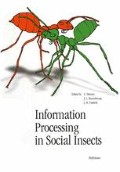Summary
In this chapter we look at the phenomenon of periodic activity cycles in ant colonies. Although most of the information on activity cycles in ant colonies is available for Leptothorax, it seems to be a phenomenon that occurs widely. Cycles of activity that last approximately one-half hour occur in colonies, with their occurrence being a function of the number of individuals that are in an aggregate or a colony. The presence of brood has an important influence on activity cycles, increasing the degree of periodicity, though brood are neither necessary nor sufficient for the production of periodic activity. We discuss models for the production of activity cycles and divide the models into two basic groups, those that require global colonywide variables that influence each colony member and those which are based on local interactions with no global connections among workers. We find that the local models, which have explicit spatial structure, are more realistic and have greater predictive power even though they are often more cumbersome to use. Finally, we consider the functional basis for periodic activity in ant colonies. There is essentially no information about the function or possible adaptive significance of this widespread, colony-level phenomenon.
Access this chapter
Tax calculation will be finalised at checkout
Purchases are for personal use only
Preview
Unable to display preview. Download preview PDF.
References
Franks NS, Bryant R, Griffiths R, Hemerik L (1990) Synchronization of the behavior within nests of the ant Leptothorax acervorum (Fabricius). I. Discovering the phenomenon and its relation to the level of starvation. Bull Math Biol 52: 597–612
Cole BJ (1991) Short-term activity cycles in ants: generation of periodicity by worker interaction. Amer Naturalist 137: 244–259
Cole BJ, Cheshire D (1996) Mobile cellular automata models of ant behavior: movement activity of Leptothorax allardycei. Amer Naturalist 148: 1–15
Cole BJ, Hoeg L (1996) The influence of brood type on the periodic activity of Leptothorax allardycei. J Insect Behav 9: 539–547
Cole BJ (1991) Is animal behavior chaotic? Evidence from the activity of ants. Proc Rl Soc Lond B 244: 253–259
Cole BJ (1994) Chaos and behavior: the perspective of nonlinear dynamics. In: L Real (ed): Behavioral mechanisms in evolutionary ecology. University of Chicago Press, Chicago, 423–443
Liebovitch L, Toth T (1991) A model of ion channel kinetics using deterministic chaotic rather than stochastic processes. J Theor Biol 148: 243–267
Cole BJ (1992) Short-term activity cycles in ants: age-related changes in tempo and colony synchrony. Behav Ecol Sociobiol 31: 181–188
Hemerik L, Britton NF, Franks NR (1990) Synchronization of the behavior within nests of the ant Leptothorax acervorum (Fabricius). I. Modeling the phenomenon and predictions from the model. Bull Math Biol 52: 613–628
Tofts C, Hatcher M, Franks NR (1992) The autosynchronization of the ant Leptothorax acervorum (Fabricius): theory, testability and experiment. J Theor Biol 157(1): 71–82
Cole BJ (1991) Short-term activity cycles in ants: a phase response curve and phase resetting in worker activity. J Insect Behav 4: 129–137
Goss S, Deneubourg JL (1988) Imitation as a source of autocatalytic synchronized rhythmical activity in social insects. Insect Soc 35: 310–315
Bailey NTJ (1964) The elements of stochastic processes with applications to the natural sciences. John Wiley, New York
Murray JD (1989) Mathematical biology. Springer, New York
Solé RV, Miramontes O, Goodwin BC (1993) Oscillations and chaos in ant societies. J Theor Biol 161: 343–357
Miramontes O, Solé RV, Goodwin BC (1993) Collective behavior of random-activated mobile cellular automata. Physica D 63: 145–160
Solé RV, Miramontes O (1995) Information at the edge of chaos in fluid neural networks. Physica D 80: 171–180
Hatcher MJ, Tofts C, Franks NR (1992) Mutual exclusion as a mechanism for information exchange within ant nests. Naturwissenschaften 79: 32–34
Cassill DL, Tschinkel WR (1995) Allocation of liquid food to larvae via trophallaxis in colonies of the fire ant, Solenopsis invicta. Anim Behav 50(3): 801–813
Editor information
Editors and Affiliations
Rights and permissions
Copyright information
© 1999 Springer Basel AG
About this chapter
Cite this chapter
Cole, B.J., Trampus, F.I. (1999). Activity cycles in ant colonies: worker interactions and decentralized control. In: Detrain, C., Deneubourg, J.L., Pasteels, J.M. (eds) Information Processing in Social Insects. Birkhäuser, Basel. https://doi.org/10.1007/978-3-0348-8739-7_16
Download citation
DOI: https://doi.org/10.1007/978-3-0348-8739-7_16
Publisher Name: Birkhäuser, Basel
Print ISBN: 978-3-0348-9751-8
Online ISBN: 978-3-0348-8739-7
eBook Packages: Springer Book Archive

